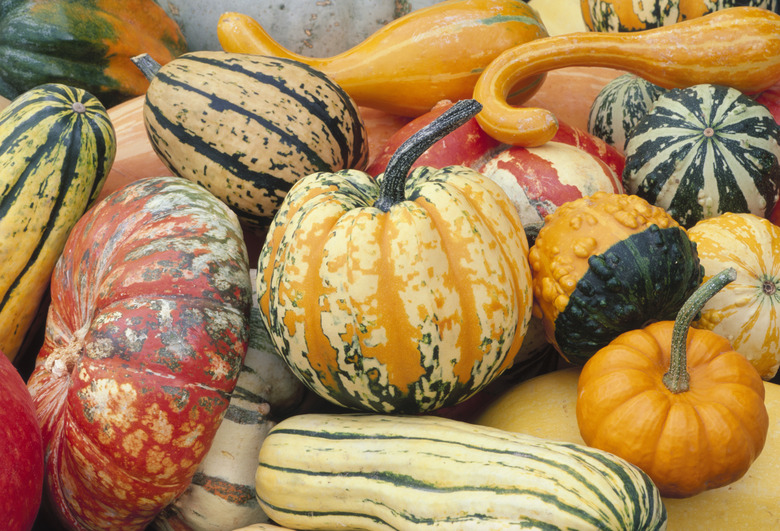Characteristics Of Squash
Squash plants make up a large and diverse group of plants called cucurbits that fall under the genus Cucurbita. Common to all squashes are large, green leaves and yellow to orange flowers. They are divided into two main types, summer and winter squash, not based on their time of harvest (since both can be harvested in summer), but because winter squash has a thick rind that gives the fruit a long-keeping quality, often through the winter months. The appearance and characteristics of squash fruit range widely, from small green zucchinis to giant orange pumpkins. Squash plants may have a bush growth habit or a vining habit.
Foliage and Flowers
Foliage and Flowers
Squash leaves tend to be very large and exhibit three to five lobes, while their stems have spines or prickles, giving them a thorny look. Unlike smaller-leafed cucumbers or melons, the lobes on squash plants aren't as deep and pronounced. The plant's fruits, flowers, seeds, and shoots are edible, along with the leaves. Flowers are large, trumpet-shaped, yellow to orange in color and have separate males and females. Male flowers produce pollen while female flowers mature into fruit. Whether you're growing winter or summer squash, the plants provide an abundant and continuous harvest through the end of the warm growing season.
Summer Squash
Summer Squash
Summer squash grow as compact, bush types or as sprawling vines, which bear fruit that is usually smaller than winter squash. Separate male and female flowers grow on the same plant. Fertilized female flowers produce fruit that is white, yellow, green, orange, or patterned, depending on the cultivar. Fruits may be round, cylindrical, or spherical with scalloped edges, also depending on cultivar. Yellow summer squash includes both straightneck and crookneck types.
Harvest summer squash when fruit is still soft and immature, 50 to 65 days after planting. Zucchini is a green summer variety that is quickly ready for picking. Pick it when it reaches 4 to 5 inches in length, but pick varieties like Costata Romanesco when they reach 6 to 10 inches long. This variety produces many male blossoms, ideal for frying and eating.
Winter Squash
Winter Squash
The key to growing winter squash is to allow plenty of room for each plant to spread. These plants can take over a garden with their fast-growing vines, big, multi-lobed leaves, and large, colorful fruit. Harvest when fruit is mature in late fall, 80 to 120 days after sowing. Many types require curing to harden the shell, and are best if baked prior to consumption. The main varieties of winter squash include acorn, buttercup and butternut varieties. Acorn squash is just 2 pounds in weight with a slightly tapered, round acorn shape. Buttercup squash is similar to acorn squash, but larger and slighly flattened. Many of them, including the Sweet Mama cultivar, store well and easily last until February. Butternut squash is tan-colored, exhibits a sweet flavor and has a cylindrical shape with a bulb on the bottom end.
Growth Requirements
Growth Requirements
Squash plants are heavy feeders that grow quickly. They prefer plenty of heat during germination. For summer squash, ideal germinating soil temperature is 95 F, while winter squash germinates best at about 90 F. Direct sowing is best with these plants as they grow fast and do not transplant well. Provide rich, well-drained soil. Harvest summer squash as soon as the fruit grows large enough, but do not allow it to over ripen or grow wrinkled in appearance. For winter squash, wait until stems dry and shrivel and skin is hard. Then cure the squash in the sun so the skin can dry completely.
